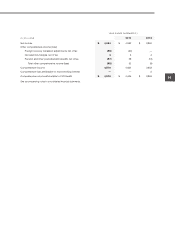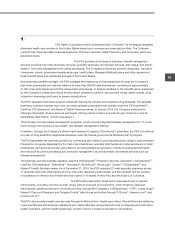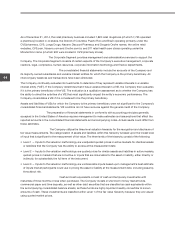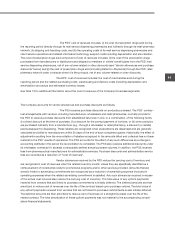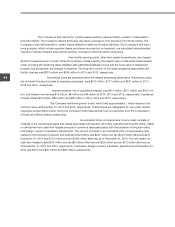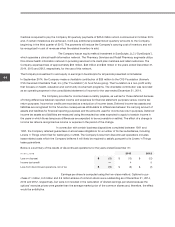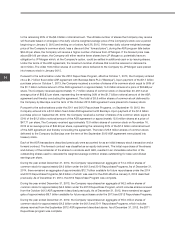CVS 2014 Annual Report Download - page 63
Download and view the complete annual report
Please find page 63 of the 2014 CVS annual report below. You can navigate through the pages in the report by either clicking on the pages listed below, or by using the keyword search tool below to find specific information within the annual report.
61
2014 Annual Report
Redeemable noncontrolling interest — In June 2012, the Company acquired the remaining 40% interest in
Generation Health from minority shareholders and employee option holders for $26 million and $5 million, respec-
tively, for a total of $31 million. The following is a reconciliation of the changes in the redeemable noncontrolling
interest for the year ended December 31, 2012:
IN MILLIONS
Balance, December 31, 2011 $ 30
Net loss attributable to noncontrolling interest (2)
Purchase of noncontrolling interest (26)
Reclassification to capital surplus in connection with purchase of noncontrolling interest (2)
Balance, December 31, 2012 $ —
Revenue Recognition
Pharmacy Services Segment
The PSS sells prescription drugs directly through its mail service dispensing pharmacies and indirectly through its
retail pharmacy network. The PSS recognizes revenue from prescription drugs sold by its mail service dispensing
pharmacies and under retail pharmacy network contracts where it is the principal using the gross method at the
contract prices negotiated with its clients. Net revenues include: (i) the portion of the price the client pays directly to
the PSS, net of any volume-related or other discounts paid back to the client (see “Drug Discounts” on the following
page), (ii) the price paid to the PSS by client plan members for mail order prescriptions (“Mail Co-Payments”) and
the price paid to retail network pharmacies by client plan members for retail prescriptions (“Retail Co-Payments”),
and (iii) administrative fees for retail pharmacy network contracts where the PSS is not the principal as discussed
below. Sales taxes are not included in revenue.
Revenue is recognized when: (i) persuasive evidence of an arrangement exists, (ii) delivery has occurred or services
have been rendered, (iii) the seller’s price to the buyer is fixed or determinable, and (iv) collectability is reasonably
assured. The following revenue recognition policies have been established for the PSS:
• Revenues generated from prescription drugs sold by mail service dispensing pharmacies are recognized when the
prescription is delivered. At the time of delivery, the PSS has performed substantially all of its obligations under its
client contracts and does not experience a significant level of returns or reshipments.
• Revenues generated from prescription drugs sold by third party pharmacies in the PSS’ retail pharmacy network
and associated administrative fees are recognized at the PSS’ point-of-sale, which is when the claim is adjudi-
cated by the PSS online claims processing system.
The PSS determines whether it is the principal or agent for its retail pharmacy network transactions on a contract
by contract basis. In the majority of its contracts, the PSS has determined it is the principal due to it: (i) being the
primary obligor in the arrangement, (ii) having latitude in establishing the price, changing the product or performing
part of the service, (iii) having discretion in supplier selection, (iv) having involvement in the determination of product
or service specifications, and (v) having credit risk. The PSS’ obligations under its client contracts for which reve-
nues are reported using the gross method are separate and distinct from its obligations to the third party pharmacies
included in its retail pharmacy network contracts. Pursuant to these contracts, the PSS is contractually required to
pay the third party pharmacies in its retail pharmacy network for products sold, regardless of whether the PSS is
paid by its clients. The PSS’ responsibilities under its client contracts typically include validating eligibility and
coverage levels, communicating the prescription price and the co-payments due to the third party retail pharmacy,
identifying possible adverse drug interactions for the pharmacist to address with the prescriber prior to dispensing,




